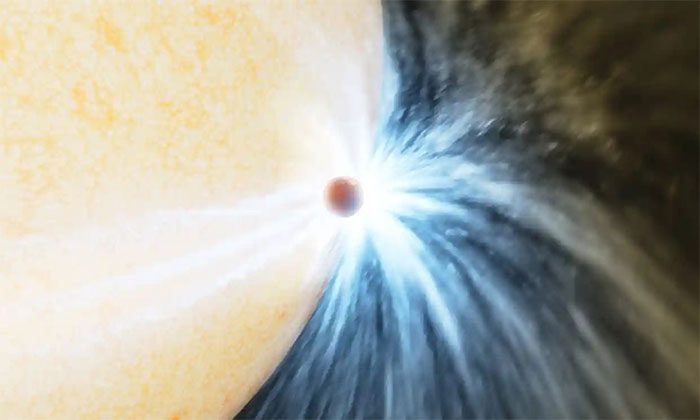Scientists believe a Jupiter-sized planet collided with its host star, resulting in an “extremely bright” light explosion.
Astronomers have witnessed the violent burst of light from a planet consumed by its host star, a dramatic fate that awaits Earth as the Sun rapidly expands towards the end of its life cycle, according to The Guardian.
This marks the first time researchers have recorded the moment when an aging star expands to the point that a nearby planet begins to slide off its surface, ejecting streams of gas and dust into space before eventually plunging into a fiery abyss.

An illustration of a planet at the end of its life sliding past the surface of its host star. (Image: K Miller/R Hurt (Caltech/Ipac)).
Mr. Kishalay De, a postdoctoral researcher at MIT in Cambridge, Massachusetts, stated, “Like many discoveries in science, this is a serendipitous finding that has truly broadened our understanding of a new phenomenon. This will be the ultimate fate of Earth.”
The first signs of this cosmic disaster emerged in 2020 when Mr. De discovered a burst of light during observations conducted as part of the Zwicky Transient Facility research at the Palomar Observatory in California. The light was traced back to a star 12,000 light-years away, near the constellation Aquila, which was brightening several hundred times in just 10 days.
The researchers in the team speculated that a stellar merger occurred, where one star absorbs another in its orbit, but subsequent observations from the Keck Observatory in Hawaii did not support this idea. Most stellar mergers expel hydrogen and helium as one star erodes the other, but the event in May showed no signs of either element.
Further observations with infrared cameras at Palomar Observatory revealed that this star was “extremely bright” in the near-infrared range, Dr. De noted. He believes that after the initial burst of hot white light, the star expelled cooler gas into space, condensing into visible dust at infrared wavelengths.
Scientists remain inclined to hypothesize about the stellar merger, but the details remained unclear until the research team analyzed additional data from NASA’s Neowise infrared space telescope. The analysis showed that the explosion was very faint, with anything falling into the host star being less than a star about 1,000 times smaller. “That’s when we realized this was a planet colliding with its host star,” Mr. De said.
By piecing the data together, Dr. De posited that this event involved a Jupiter-sized planet orbiting its host star extremely quickly, completing an orbit in less than a day. It began sliding across the surface of the star about nine months before the light explosion occurred and continued for several hundred orbits before ultimately plunging into the star, causing it to brighten rapidly and then fade away.
“The star now looks very similar to how it did before the explosion, except it is surrounded by a shell of dust that was ejected during the explosion,” Dr. De stated. The details of this discovery were published in the journal Nature.
When a star exhausts its fuel at the end of its life cycle, it expands to a million times its original size, engulfing nearby planets in the process. When the Sun reaches this point in the future, it will swell enough to consume Mercury, Venus, and Earth.
Morgan MacLeod, an astrophysicist in the research team at Harvard, commented: “People living in this era may not need to think about this yet, as it will not happen for another 5 billion years. We believe that the conditions on the planets will be quite harsh by that time since the Sun will also heat up, causing all water to evaporate from Earth, making it uninhabitable.”


















































